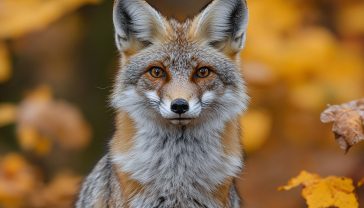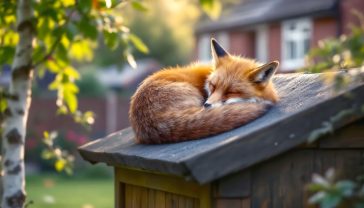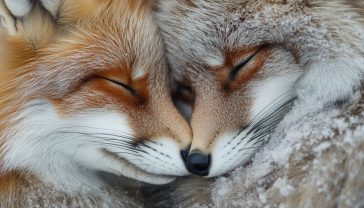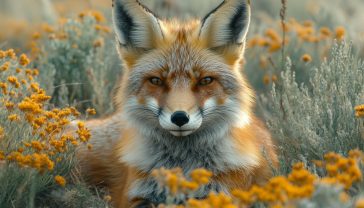What Is a Group of Foxes Called? The Curious Origins of “Skulk” and “Leash”
The definitive guide to collective nouns for foxes. We explore the medieval origins of ‘skulk’ and ‘leash’ and the truth about fox behaviour in modern Britain.
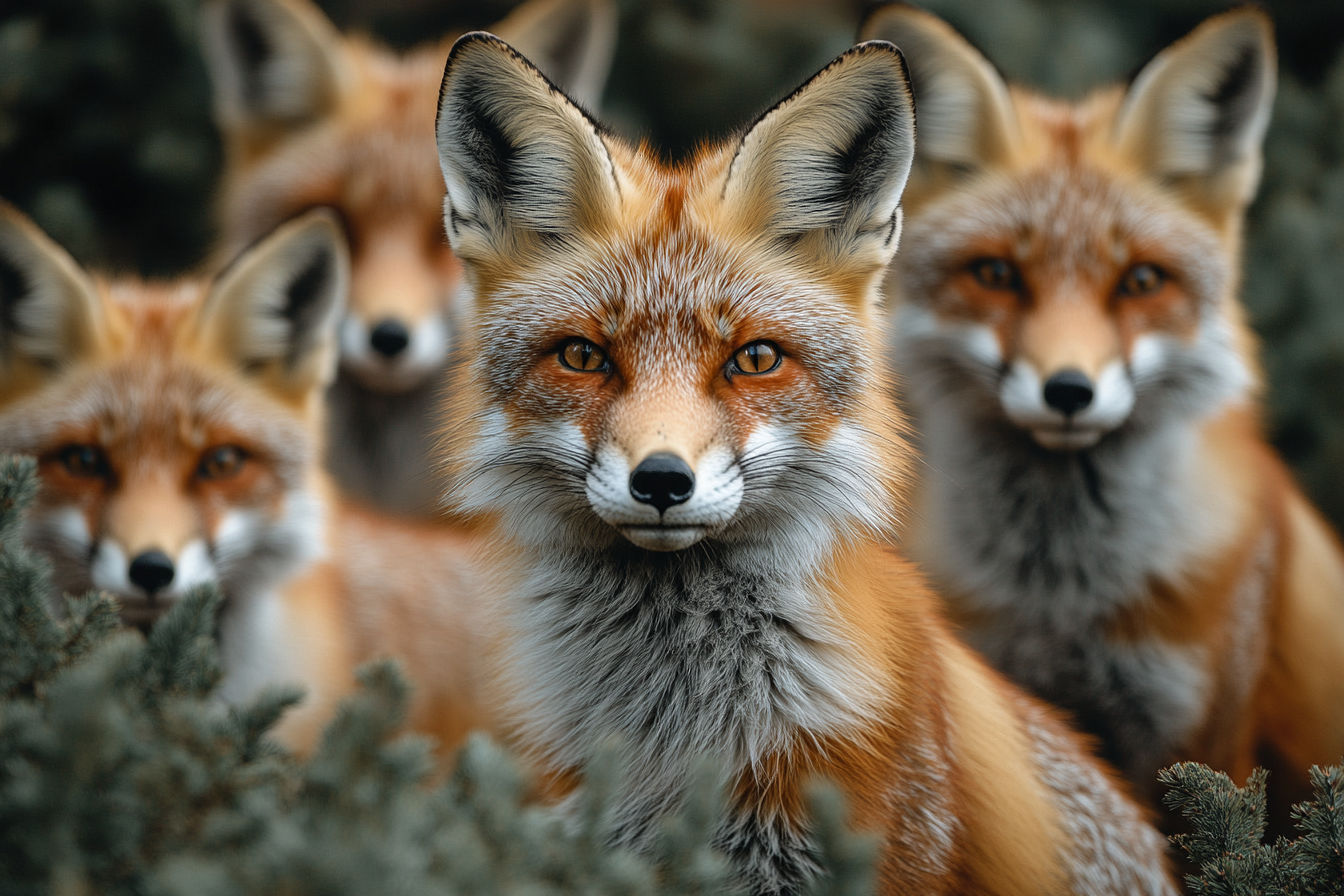
This post may contain affiliate links. If you make a purchase through these links, we may earn a commission at no additional cost to you.
It’s a scene familiar to millions of us across Britain. You’re washing up after dinner, gazing out of the kitchen window as the evening light fades to a deep blue. Then, a flicker of movement. A flash of russet fur, a pointy snout, and a magnificent bushy tail. A fox, picking its way silently across your lawn. But then, another follows, and perhaps a third, smaller one bounces after it. Suddenly, you’re not just watching a fox; you’re watching a family, a team, a… well, a what?
What do you call a group of foxes?
It’s a simple question, but the answer opens a door into history, language, and the secret life of one of Britain’s most iconic and misunderstood animals. The most common answer you’ll hear is a skulk of foxes. The more old-fashioned or poetic term is a leash of foxes.
But these aren’t just random words. They are clues. They tell a story about how our ancestors saw these animals and how their behaviour is so perfectly captured in the quirky richness of the English language. So, let’s dive in and uncover the history behind these strange and wonderful names, and in doing so, get to know the fox a little better.
The Short Answer: Skulk, Leash, and Other Curiosities
For those of you who just want the quick facts, here they are. The most widely accepted and descriptive term for a group of foxes is:
- A skulk of foxes: This is the most popular and fitting term used today.
- A leash of foxes: This is a historical term, often referring to a specific number of foxes (three) and is tied to the language of hunting.
You might also occasionally stumble across other, rarer collective nouns for foxes, such as a cloud, a troop, or a company of foxes. And if you’re talking about their den, that’s called an earth or a lair. But for now, let’s focus on the two main players: “skulk” and “leash.” They have the most fascinating stories to tell.
Unravelling the “Skulk”: A Name Born from Behaviour
Of all the collective nouns, skulk feels just right, doesn’t it? You can almost picture it. The word itself sounds sneaky and secretive, perfectly capturing the essence of the fox.
What Does “Skulk” Mean?
The word “skulk” drifted into the English language from Scandinavia. It’s related to Old Norse words like skulka, which means “to lurk,” “shirk,” or “move stealthily.” It carries a sense of hiding, of moving with questionable intent, of being up to no good. When someone is skulking, they’re not striding confidently; they’re creeping in the shadows, hoping not to be seen.
Sound familiar?
Why It’s the Perfect Fit for a Fox
This description is a perfect match for the fox’s behaviour, especially from a human perspective. Foxes are masters of the unseen world. They are crepuscular, which is a fancy way of saying they are most active at dawn and dusk, the shadowy times of the day.
They move with a silent, fluid grace, using their incredible senses to navigate their territory. Their reputation for being sly tricksters and cunning survivors isn’t an accident. For centuries, farmers saw them as thieves, skulking around henhouses. Gamekeepers saw them as poachers, lurking near their pheasant pens. Even today, watching a fox in an urban garden, you’ll see it stick to the shadows, moving cautiously from one patch of cover to the next. It’s the very definition of skulking.
So, when we call a group of them a “skulk,” we’re not just labelling them. We’re describing their collective character—a silent, watchful, and wary group, bound by a common purpose, whether it’s hunting, playing, or simply moving through a world full of dangers.
The Mystery of the “Leash”: A Term from the Hunt
While “skulk” is about behaviour, leash is about something else entirely: history and numbers. It’s a much older and more formal term, and it takes us back to the world of medieval Britain.
Not a Dog Lead: The Historical Meaning
Today, we think of a leash as something you use to walk a dog. But in medieval times, the word had a different meaning. A “leash” often referred to a set of three.
This meaning is still hiding in our language if you look closely. For instance, in hunting, you might have a “leash of hounds,” meaning a group of three dogs. This term was part of a specialised vocabulary used by the nobility, a way of showing you were educated in the proper customs of the field. And just as you could have a leash of hounds, you could also have a leash of foxes—three foxes, counted together.
A Glimpse into Medieval Britain: Terms of Venery
To understand where “leash” comes from, we need to talk about Terms of Venery. This sounds complicated, but it’s just the historical name for collective nouns, specifically for animals that were hunted. “Venery” was the medieval word for the sport of hunting.
In the 15th century, it was fashionable for the land-owning gentry to use these colourful, descriptive terms. It was like a secret code, a sign that you belonged to the elite hunting classes. Knowing that you call a group of crows a “murder” or a group of owls a “parliament” was a status symbol.
The most famous source for these terms is The Book of Saint Albans, first printed in 1486. It’s a collection of essays on hawking, hunting, and heraldry. Traditionally, it’s attributed to a woman named Dame Juliana Berners, who was thought to be the prioress of a convent. The book lists over 160 collective nouns, including many we still know today, like a “pride of lions” and a “gaggle of geese.”
The Book of Saint Albans is where many of these terms were first written down, and a “leash of foxes” fits right into this tradition. It was the correct, formal language for a nobleman to use when discussing his quarry.
Why Three? The Practicalities of the Hunt
Why the number three was so significant is a little harder to pin down. It might be because hounds were often unleashed in groups of three to track a scent. Or it could simply be that seeing three foxes together was a notable event, worthy of its own specific term.
Whatever the reason, the word “leash” anchors the fox firmly in Britain’s social and hunting history. It reminds us that for centuries, the fox was seen not just as a wild animal, but as quarry—a key player in the aristocratic rituals of the hunt.
Beyond the Big Two: Other Collective Nouns for Foxes
While skulk and leash are the main contenders, the creativity of the English language didn’t stop there. Over the years, a few other names have been suggested, though they are much less common:
- A Cloud of Foxes: This is a wonderfully poetic term. It suggests a group of foxes moving with a silent, almost ethereal quality, like a cloud drifting across the landscape.
- A Troop or Company of Foxes: These terms are more generic and less descriptive. They imply a more organised group, which, as we’ll see, isn’t quite how foxes operate.
- An Earth of Foxes: This is technically incorrect, as an “earth” is the name for a fox’s den. However, you can see how the term might be stretched to include the family living inside it, just as we might say “a house of people.”
These terms show our ongoing fascination with trying to find the perfect word to capture the spirit of this elusive animal.
But Do Foxes Actually Live in Groups? A Look at Fox Society
This is the big question. We have all these words for a group of foxes, but are they actually sociable animals? We often think of them as solitary loners, but the truth is more complex and far more interesting.
The Truth About the “Solitary” Fox
Foxes are not pack animals in the same way as wolves. A wolf pack is a highly structured, cooperative unit that hunts large prey together. Foxes, on the other hand, are solitary hunters. They typically hunt for small prey like mice, voles, beetles, and earthworms, which isn’t a job that requires teamwork.
However, they are not completely solitary either. They live in small family groups. The classic image of a lone fox trotting across a field is usually a fox on a hunting mission. Back at the den—the earth—there’s often a whole family waiting.
The Fox Family Unit: Dog, Vixen, and Cubs
A typical fox family group is centred around a breeding pair: the dog fox (male) and the vixen (female).
- The Vixen: She is the heart of the family. After mating in the winter, she gives birth to a litter of cubs in the spring, usually underground in the safety of the earth. For the first few weeks, she stays with the cubs constantly, feeding them her milk.
- The Dog Fox: He’s the provider. While the vixen is nursing the cubs, the dog fox hunts for them both, bringing food back to the den. He is a dedicated partner and father.
- The Cubs (or Kits): A vixen usually has a litter of four or five cubs. They are born blind and deaf, but grow quickly. After about a month, they start to emerge from the earth to play and explore. This is the time you are most likely to see a “skulk” of foxes together.
- The Helpers: Sometimes, a fox family will also include other adult foxes, often vixens from a previous year’s litter who haven’t yet found a territory of their own. These “aunts” help the main vixen by bringing food for the cubs and acting as babysitters.
When and Why They “Skulk” Together
So, a “skulk” of foxes is most often a mother, a father, and their young cubs. You’ll see them gathered near the earth in late spring and early summer, playing, socialising, and learning the skills they’ll need to survive. The play isn’t just for fun; it’s serious business. Through play-fighting, they establish a social hierarchy and practice hunting and stalking techniques.
As the summer goes on and the cubs get older, they will become more independent. By the autumn, the family group starts to break up as the young foxes leave to find their own territories. That’s why you’re more likely to see a single fox in the autumn and winter months.
The Rise of the Urban Fox: A Modern British Skulk
For many of us in Britain, our main experience with foxes isn’t in the rolling countryside but right in our back gardens. The urban fox is a masterclass in adaptation.
From Countryside to Cul-de-Sac: Why Foxes Moved to Town
Foxes began colonising our towns and cities in a big way after the 1930s. The expansion of suburbs created a perfect habitat for them: a patchwork of gardens, parks, railway embankments, and cemeteries, with plenty of places to hide and find food.
Our messy, wasteful human habits have been a huge help to them. Discarded takeaways, overflowing bins, and food left out for pets or other wildlife provide an easy and reliable source of calories. In return, they help control populations of rats and pigeons.
Are City Foxes Different?
Studies have shown that urban foxes have adapted their behaviour to city life. They live in smaller territories because food is so readily available. They have also become much bolder and more accustomed to the presence of humans, which is why we are able to see them so often.
While they may look scruffier than their country cousins—partly due to the challenges of mange in denser populations—they are the same species. They are simply brilliant opportunists who have learned to thrive in the world we’ve built.
The Urban Skulk: A Common Sight in British Gardens
It’s in our towns and cities that you are now most likely to witness a skulk of foxes. A quiet, well-managed garden can be the perfect place for a vixen to raise her cubs, safe from many of the dangers of the countryside. Spotting a vixen leading her cubs on a nightly exploration of the neighbourhood has become a cherished highlight for many British homeowners.
Foxes in British Culture: From Villain to Folk Hero
Our long and complicated relationship with the fox is reflected in our culture. It has been cast in many roles over the centuries: as a pest, a cunning villain, a symbol of wildness, and a beloved children’s character.
Reynard the Fox: The Cunning Archetype
The idea of the fox as a clever trickster goes back to medieval European folklore, particularly the stories of Reynard the Fox. In these tales, Reynard is an aristocratic anti-hero who uses his wits to outsmart more powerful animals like the wolf and the bear. He’s a rebel who thumbs his nose at authority, a character that has always appealed to the British sense of the underdog.
Beatrix Potter to Fantastic Mr Fox
This image of the cunning but charming fox is everywhere in our children’s literature. Think of Beatrix Potter’s gentlemanly but foolish Mr. Tod, or the ultimate folk hero, Roald Dahl’s Fantastic Mr Fox. Mr Fox provides for his family by outsmarting the three nasty farmers—Boggis, Bunce, and Bean. He is a hero, a devoted father, and a symbol of defiance against greed.
The Red Coat Debate: The Fox and the Hunt
Of course, no discussion of the fox in Britain would be complete without mentioning fox hunting. For centuries, the image of riders in red coats chasing a fox with a pack of hounds was a defining, if controversial, part of rural life.
The debate around the hunting ban in 2004 was fierce and emotional. To some, the fox was “vermin” that needed to be controlled. To others, it was a beautiful, intelligent animal being persecuted for sport. This cultural clash shows just how deeply the fox is woven into the British identity and how differently it can be perceived.
A Peculiarly British Obsession: The Joy of Collective Nouns
Our journey to find the name for a group of foxes reveals something wonderful about the English language itself: its love of descriptive, specific, and sometimes downright weird words.
Why Do We Have So Many?
This tradition of creating collective nouns, the “Terms of Venery,” was a playful way to categorise the world and demonstrate knowledge. It added poetry and personality to the language. Each name was an attempt to capture the unique spirit of an animal or group.
From a Murder of Crows to a Parliament of Owls
The fox is not alone in having such evocative group names. Consider these other gems of the English language:
- A murder of crows (evoking their harsh calls and scavenging nature)
- A parliament of owls (for their supposedly wise, solemn appearance)
- An exaltation of larks (for their beautiful, soaring song)
- A murmuration of starlings (describing the sound and shape of their huge winter flocks)
These words aren’t just labels. They are tiny poems, rich with history and observation.
What to Do If You See a Skulk of Foxes
Seeing a skulk of foxes in your garden can be a magical experience. The advice from wildlife experts like the RSPCA and The Wildlife Trusts is simple.
Enjoying Your Local Wildlife Safely
The best thing you can do is watch them from a distance, perhaps from a window, so you don’t disturb them. Observe their behaviour—how the cubs play, how the parents watch over them. It’s a privilege to have a window into their secret world.
To Feed or Not to Feed? The Expert View
It’s tempting to leave out food for them, but it’s generally not recommended. Foxes are excellent scavengers and don’t need our help. Feeding them can cause several problems:
- It makes them dependent and less wary of humans, which can put them in danger.
- It can attract unwanted visitors, like rats.
- It can cause disputes with neighbours who might not be so keen on them.
- It can lead to overpopulation in a small area, which can help spread diseases like mange.
If you do want to help, the best thing you can do is leave a bowl of fresh water out during dry spells.
When to Be Concerned
A healthy fox is a beautiful sight. However, if you see a fox that looks very unwell—perhaps with extensive fur loss (a sign of sarcoptic mange), is clearly injured, or is behaving strangely (e.g., being active and approachable in the middle of the day)—then it may need help. In these cases, you can contact the RSPCA or a local wildlife rescue for advice.
Conclusion: More Than Just a Word
So, what is a group of foxes called? It’s a skulk, a name that perfectly captures its stealthy nature. Or, if you’re a historian, it’s a leash, a term that echoes with the sounds of medieval hunting horns.
But as we’ve discovered, that simple question leads us to a much deeper understanding of this incredible animal. The words we use for the fox tell us about its behaviour, its family life, and its long, complicated history with the people of Britain.
The next time you look out of your window and see that flash of russet fur in the twilight, you’ll know you’re not just looking at a fox. You’re looking at a member of a skulk, a cunning survivor, a dedicated parent, and a living piece of British history, silently making its way through our modern world. And that’s a wonderful thing to see.
Further Reading
For those interested in learning more about foxes and British wildlife, these resources are highly recommended:
- The Wildlife Trusts: An excellent source of information on British fauna and flora, with specific guides on foxes.
- The RSPCA (Royal Society for the Prevention of Cruelty to Animals): Provides expert advice on living alongside urban foxes and what to do if you find an animal in distress.
- The Mammal Society: A charity dedicated to the study and conservation of British mammals, offering detailed scientific information on the red fox.
- The British Library: You can find digitised versions and articles about historical texts like The Book of Saint Albans.

